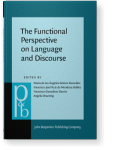Besides as a connective
This chapter throws new light upon besides as a connective in contemporary
English. Using examples extracted from corpora, we consider how to reconcile
the notions of “tangentiality” and “decisiveness” found in existing descriptions
of its function. After an assessment of the only previous publication fully
devoted to besides, Yeung (2009), we identify two major uses, which we label
objective and (inter)subjective. The objective use is connected to finality, with
besides marking the last argument in a chain, while the (inter)subjective use
invokes a more (inter)personal viewpoint that trumps the preceding arguments.
We also show that such uses were absent in the 19th century. This allows the
conclusion that besides developed its distinctive characteristics in relatively
recent times, predominantly in dialogue.
References (18)
References
Ball, Wilson J. 1986.
Dictionary of Link Words
. London: Macmillan.
Butler, Christopher S. 1985.
Computers in Linguistics
. Oxford: Blackwell.
Butler, Christopher S. 2000. “Corpus Linguistics and the Teaching and Learning of Languages.” In
Proceedings of the 22nd International Conference of AEDEAN
, ed. by Pere Gallardo, and Enric Llurda, 15–27. Lleida: Universitat de Lleida.
Butler, Christopher S. 2008. “The Subjectivity of Basically in British English”. In
Pragmatics and Corpus Linguistics: A Mutualistic Entente
, ed. by Jesús Romero-Trillo, 37–63. Berlin: Mouton de Gruyter.
Cobuild. 2009.
Collins Cobuild Advanced Dictionary
. Glasgow: Collins and Boston MA: Heinle Cengage Learning.
Davies, Mark. 2004.
BYU-BNC
. (Based on the British National Corpus from Oxford University Press). Available online at [URL].
Davies, Mark. 2008.
The Corpus of Contemporary American English: 450 Million Words, 1990–Present
. Available online at [URL].
Davies, Mark. 2010.
The Corpus of Historical American English: 400 Million Words, 1810–2009
. Available online at [URL].
Gilquin, Gaëtenelle, and Magali Paquot. 2007. “Spoken Features in Learner Academic Writing: Identification, Explanation and Solution.” In
Proceedings of the Fourth Corpus Linguistics Conference
, ed. by Matthew Davies, Paul Rayson, Susan Hunston, and Pernilla Danielsson. University of Birmingham, UK. Available online at: [URL], consulted on 29 September 2012.
Hannay, Mike, and J. Lachlan Mackenzie. 2009.
Effective Writing in English: A Sourcebook
. 2nd edition. Bussum: Coutinho.
Hornby, A. S. 2005.
Oxford Advanced Learner’s Dictionary
. 7th edition. Oxford: Oxford University Press.
Leech, Geoffrey N., Marianne Hundt, Christian Mair, and Nicholas Smith. 2009.
Change in Contemporary English: A Grammatical Study
. Cambridge: Cambridge University Press. 

Longman Dictionary of Contemporary English. 2003. 4th edition. Harlow: Pearson.
Quirk, Randolph, Sidney Greenbaum, Geoffrey N. Leech, and Jan Svartvik. 1985.
A Comprehensive Grammar of the English Language
. London: Longman.
Rundell, Michael. 2007.
Macmillan English Dictionary for Advanced Learners
. 2nd edition
. Oxford: Macmillan.
Swan, Michael. 2005.
Practical English Usage
. 3rd edition. Oxford: Oxford University Press.
Traugott, Elizabeth C. 1997. “The Role of the Development of Discourse Markers in a Theory of Grammaticalisation.” Paper presented at ICHL XII, Manchester 2005. [URL]. Consulted on 29 September 2012.
Yeung, Lorrita. 2009. “Use and Misuse of ‘Besides’: A Corpus Study Comparing Native Speakers’ and Learners’ English.
” System
37: 330–342. 

Cited by (3)
Cited by three other publications
Iza Erviti, Aneider
2021.
Complementary Contrastive Constructions. In
Discourse Constructions in English [
Yearbook of Corpus Linguistics and Pragmatics, ],
► pp. 75 ff.

Iza Erviti, Aneider
2021.
From Discourse Markers to Construction Grammar(s) in Discourse. In
Discourse Constructions in English [
Yearbook of Corpus Linguistics and Pragmatics, ],
► pp. 7 ff.

This list is based on CrossRef data as of 24 july 2024. Please note that it may not be complete. Sources presented here have been supplied by the respective publishers.
Any errors therein should be reported to them.
